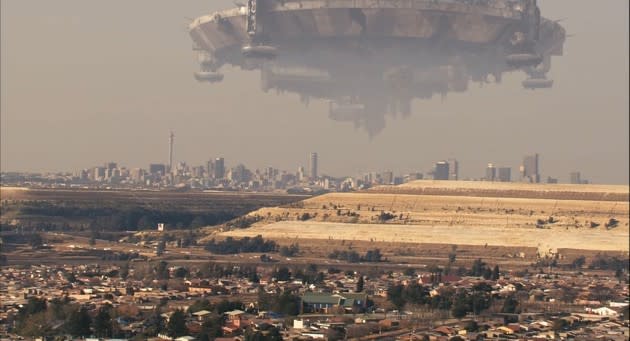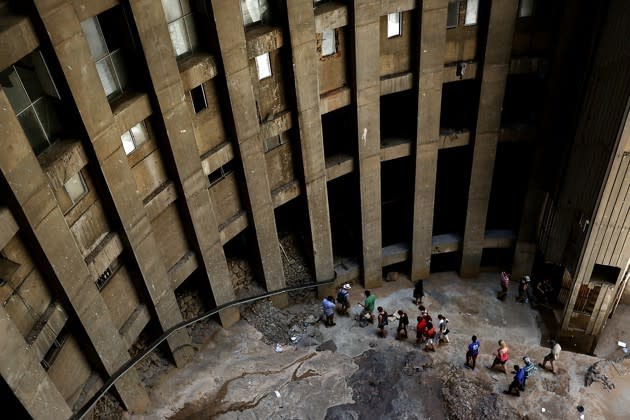The South African Building That Came to Symbolize the Apocalypse
It was 10 a.m. on a bright spring morning in Johannesburg, and just outside my apartment, the zombie horde was growing restless. They shrieked and wailed, clawing at their tattered gray clothes and surging toward the walls around them. As they thrashed against concrete and barbed wire, I heard shots ring out. There was a guttural yell and then, abruptly, silence.
Finally. For three days, the undead had been interrupting my workdays to fight pitched, cacophonous battles with their human nemeses on the movie set of Resident Evil: The Final Chapter 30 floors below my kitchen window.
A post shared by Ryan (@ryanlenora) on Sep 21, 2015 at 2:20am PDT
When I had moved into Africa’s tallest apartment building a year earlier, I hadn’t counted on my work as a journalist being interrupted by a zombie apocalypse. But in many regards, I had to admit, it made sense. For more than four decades, after all, the Ponte City tower, which juts out over downtown Johannesburg like a 54-story toilet-paper tube, has been a vertical warehouse for South Africans’ greatest hopes and worst fears about their cities and themselves.
Recommended: The Case for Shyness
Built at the center of a buzzy, international neighborhood, Ponte began life as a posh address for white residents in the 1970s. The building’s unusual architecture—its flats all face a gaping open core—lent it a distinct, if eerie, appeal from the outset. But as the fall of apartheid transformed the city center, the building was dragged along with it, morphing into an outsized symbol of the violence and decay that gripped parts of Johannesburg during South Africa’s messy transition to democracy in the 1990s.
By the time I arrived there, Ponte was shorthand in local media and the public imagination for a city transformed—or, depending on who you asked, destroyed—by the warp of history. Now, it seemed that Hollywood had figured out the logical end point of that metaphor. Over the past few years, the building has appeared in several international films (its credits include District 9, Chappie, and a Drake music video, among others), always as a place both desolate and dangerous. But Resident Evil, which opened in late January in the U.S., took it a step further. It picked Ponte up out of downtown Johannesburg, and dropped it down in the middle of a gutted metropolis at the end of human history. The symbolism was hard to miss.
In September 2015, a couple of days before Ponte transformed into Resident Evil’s zombie wasteland, a notice from the management appeared posted on walls around the building.
Recommended: Why Listening to Murder Stories Makes Some People Less Anxious
“DEAR TENANTS OF PONTE CITY,” it read. “THERE ARE PEOPLE SHOOTING A MOVIE IN THE BUILDING SO THERE WILL BE GUN SHOTS THAT YOU WILL HEAR, SO PLEASE JUST KEEP CALM DO NOT PANIC.”
This wasn’t much of a surprise. It was hardly the first time that downtown Johannesburg had caught the attention of filmmakers searching for a city whose landscape could quickly telegraph violence and disarray. This was the same city that The Hulk smashed to pieces in 2015’s Avengers: Age of Ultron, and the same “dystopic irradiated wasteland” that Judge Dredd and his crew chased bad guys through in the comic book cum 2012 action movie Dredd. (That film even centers on a 200-story slum tower with a gaping open center—a clear Ponte remake.)
And Ponte itself has had many a sordid film cameo. Alien space ships hovered above it in District 9, gangsters staged dogfights in its haunting circular “core” in Chappie, and Navy Seals stormed through the building in search of a team of Congolese warlords in Seal Team 8: Behind Enemy Lines (that film, whose urban scenes are shot in South Africa, ostensibly takes place in the Democratic Republic of the Congo). Drake filmed the climactic gangster-showdown scenes in his surreal 20-minute extended music video “Please Forgive Me” there. And in between, the building has been used to sell everything from beer to McDonalds. With a few exceptions, there are some common motifs among all these takes on Ponte: fire, garbage, garbage on fire, and of course, lots and lots of gunshots.

While some of the fictional stories Ponte appears in are set in downtown Johannesburg, many are not. But to South Africans, the tower’s oddball architecture means it is recognizable even if it is supposedly somewhere else. And wherever Ponte is dropped down in the world, what the tower represents tends to be the same—a desolate, lawless place where society’s rules have little meaning.
Recommended: 'Truth Is What You Can Get Away With'
For filmmakers, the building’s appeal lies at the intersection of its weird history and weirder aesthetics, says Genevieve Hofmeyr. Her production company, Moonlighting Films, worked on the South African segments of Resident Evil: The Final Chapter, the sixth installment in the video-game-turned-action-movie series about a woman attempting to save humanity after a deadly virus turns most of the species into zombies. “From the minute the director [Paul W.S. Anderson] saw Ponte while scouting in Johannesburg, he recognized its unique architecture and immediately visualized a sequence there,” she says. “The look and character of Ponte personifies urban grit. Its character has morphed over time to fit perfectly into a post-apocalyptic world.”
By “character” Hofmeyr likely means Ponte’s longstanding and fearsome reputation as a “tower of babel,” a “den of iniquity run by drug dealers and thugs,” a “dirty, dangerous place” and a building that “wouldn’t be lost in a sci-fi horror.” For decades, indeed, rumors about the building have taken on a caricatured and almost cinematic quality that makes its recent leap into film in some ways unsurprising. For instance, one particularly tenacious—though unproven—piece of local lore holds that during the early 1990s, the building’s core was filled with garbage 10 stories high, chucked by residents from their windows because the city never came to collect.
But the story of how Ponte came to “fit perfectly” into anyone’s post-apocalyptic world is worthy of a blockbuster in its own right. When it was built in the 1970s, the otherworldly concrete cylinder wasn’t meant to represent the end of days, but rather an ambitious new beginning. An ode to the gods of brutalism on par with anything Europe or America might produce, Ponte was a projection of white South Africa’s desire to be seen as Western and sophisticated—even as its parochial racial politics said otherwise.

“I lined the walls of the penthouses with shaggy dog orange carpet—it was all very posh,” said Rodney Grosskopff, then a young partner in the architectural firm of Manfred Hermer, which designed Ponte, when I interviewed him about the building in 2014. “Everyone wanted to say they’d stayed in the tallest apartment building in Africa.” Even as the final touches were being put on Ponte’s top floors, however, the city it was built to represent was falling apart. In 1976, the year the building officially opened, residents with flats facing southwest could see smoke rising from behind the yellow mine dumps that marked the edge of the city. Just beyond it, the black townships of Soweto were on fire.
As mass protests against apartheid built in intensity and violence on the city’s fringes, many black South Africans who could afford to began illegally migrating into the inner city. There, they found landlords all too willing to look the other way on the legality of the arrangement—as long as the new tenants didn’t complain about details like massive rent hikes. To make up for the high prices, residents packed in, sometimes two or three families to a single flat. Meanwhile, without care from management, their buildings decayed briskly. Within a decade, most white residents had fled. By the 1990s, as Nelson Mandela walked free from prison and millions of black South Africans lined up to vote for the first time, Ponte hovered above a neighborhood gently described as “transitioning.”
There was always another side to Ponte, however. Even in its darkest days, the place was mostly prosaic, a large apartment building that was home to a decidedly undramatic cast of families, students, and migrants toiling on the edges of South Africa’s middle class. Although that might have been the dominant experience of residents, it’s a side of Ponte’s history that rarely made it into newspapers—and it certainly didn’t touch the kind of popular imagination that would soon turn Ponte into an international film set.
The worlds we invent always convey something about the world we know.
There’s a simple reason for that, says Zahira Asmal, a South African researcher who writes frequently about the country’s cities. “Throughout Johannesburg’s history, it’s been as if the inner city doesn’t exist when white people—specifically white men—aren’t looking at it, as though its life and legitimacy depend on people in power paying attention,” she says. What outsiders saw when they did turn to look at Ponte and the inner city—now mostly black and increasingly international—was their own fears about what Johannesburg had become, she says.
That has held for filmmakers too, says Alexandra Parker, the author of Urban Film and Everyday Practice: Bridging Divisions in Johannesburg. “Most filmmakers in South Africa are still white, so films do often track white perception of the inner city, not necessarily the personal experiences of people living there,” she says. And international filmmakers have largely picked up on that same imagery to cast the city as a seedy underworld. In recent years, meanwhile, Johannesburg’s actual inner city has changed rapidly, a combination of intensive efforts at gentrification, old-fashioned clean-ups, and better policing. But “the city changes faster than its films,” Parker says.
Still, the long half-life of perception—and the way film seems to freeze in amber a version of the city many are trying hard to forget—means that Johannesburg still struggles to recast its image. “Every time I start a tour I ask people what they know about the inner city, and every time, the answer is the same—this place is full of crime, drugs, prostitution,” says Franck Leya, who runs tours of Ponte and the inner city with a company called Dlala Nje. “And when I ask how people know that, they tell me it’s what they’ve seen [in movies and television].” Ponte in particular seems to be a mythological site for many of his visitors. And when they recount what they know of the building’s history to him, Leya says their choppy horror stories often seem to blur together real-life details with cinematic fictions.
“We spend years of our lives trying to change the way people see this place, but it can’t match up to the millions of dollars spent on one movie that shows the opposite,” he says. Of course, for a zombie movie or a comic-book action flick, having only a glancing affinity to reality is precisely the point. The hollowed out Raccoon City of Resident Evil isn’t inner-city Johannesburg, exactly—it’s not meant to be. But Ponte didn’t become the site of the film’s apocalypse by accident. The worlds we invent always convey something about the world we know.
Or in this case, worlds we don’t. “The problem here,” says Leya, “is that people are still telling scary stories about a place they actually know nothing about.”
Read more from The Atlantic:
This article was originally published on The Atlantic.
